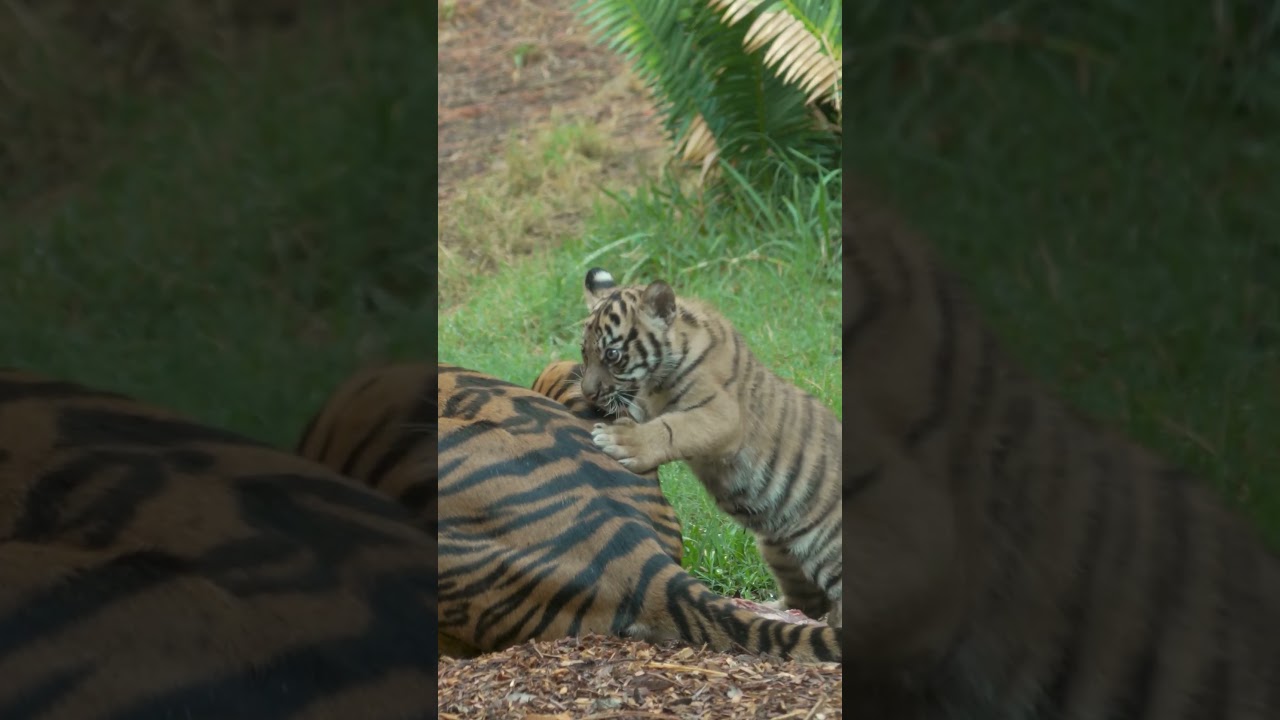- The early life and development of Barong, revealing insights into its behavior and growth as a young tiger.
- The importance of play and social interactions in the cognitive and physical development of tiger cubs.
- Conservation efforts focused on tigers and the role zoos play in safeguarding the species.
- Ethical zoo management practices ensuring the welfare and natural behaviors of animals like Barong.
- The impact of educational programs and media, such as videos, in raising public awareness about wildlife conservation.
Throughout Barong’s juvenile period, important observations were made regarding the behaviors and physical characteristics typical of young tigers. From birth, tiger cubs, including Barong, exhibit a set of innate behaviors necessary for survival and development. These include suckling, exploring their environment, and communicating with siblings and caregivers through various vocalizations. The dependency period of cubs is crucial as it allows them to learn essential survival skills.
During these early stages, Barong showed increasing independence that was shaped by both instinct and environmental factors. Studying these behaviors in Barong offers valuable insights into the developmental stages that all tigers undergo. Understanding these stages aids zoologists and conservationists alike in formulating effective breeding and rearing programs for tigers in captivity. The aim is to preserve their natural behaviors and increase their chances of successful reintroduction into the wild when possible.
The importance of play behavior in tiger cubs, including Barong, cannot be understated. Play serves as a fundamental activity through which cubs develop coordination, strength, and social skills. In Barong’s case, playful interactions with other cubs and environmental stimuli were essential for honing hunting skills and learning social cues. Studies in zoology have shown that such interactions are crucial for cognitive development.
Play also functions as a stress reliever, enhances physical fitness, and fosters bond formation among cubs. These activities mimic the hunting and survival skills required in their natural habitats. In controlled settings, zookeepers facilitate similar environments by introducing various enrichment activities. These activities ensure that animals like Barong engage in stimulated and challenging play, necessary for their mental well-being.
The conservation of tigers is a subject of global importance. With wild populations dramatically decreasing due to habitat destruction, poaching, and human-tiger conflict, efforts to conserve these majestic creatures are more critical than ever. Tigers, such as Barong, often serve as ambassadors for their wild counterparts. Zoos worldwide, including those housing young tigers like Barong, participate in various breeding programs designed to maintain genetic diversity.
The role of educational initiatives in these conservation programs cannot be overlooked. Through interactive exhibits and engaging video content, zoos to raise awareness and empathy among the public. The portrayal of Barong’s formative years across different media platforms plays a pivotal role in educating viewers on the challenges tigers face in the wild and the necessary steps to protect them. These narratives not only raise awareness but inspire action and support for conservation efforts.
Ethical zoo management is at the heart of providing a safe and enriching environment for all animals, including young tigers like Barong. Best practices in zoo management involve creating habitats that cater to the physiological and psychological needs of animals. Environments are designed to mimic natural conditions as closely as possible, allowing for the exhibition of natural behaviors. For Barong, this includes opportunities for climbing, swimming, and interacting with various objects and materials that simulate natural prey.
Furthermore, ethical management includes providing comprehensive veterinary care and nutrition tailored to the needs of developing cubs. Welfare assessments ensure that animals receive appropriate social interaction and stimulation. Ensuring such standards promote healthier, happier lives for tigers under human care and contributes to the overall success of conservation programs.
The impact of educational media on public perception of wildlife conservation is profound. Videos of young tigers like Barong growing up provide an intimate look into the lives of these fascinating creatures. These glimpses, captured in engaging formats, highlight the playful and innocent nature of young tigers, fostering a connection with audiences. They serve as a reminder of the natural beauty that exists within our ecosystem, encouraging a global audience to participate in conservation efforts.
Through digital platforms, these messages reach a wide audience, transcending geographical barriers. The compelling story of Barong can inspire viewers from around the world to appreciate the importance of preserving biodiversity. By combining the educational aspects of zoology with the captivating appeal of media, a broader public understanding and appreciation of tiger conservation can be achieved.
Barong’s journey from a young cub to a mature tiger highlights many aspects of tiger biology, the importance of ethical zoo practices, and the role of media in wildlife conservation. These key areas intersect to provide a comprehensive view of the efforts being made to protect tigers and their habitats. As the story of Barong continues to captivate audiences, it fuels the ongoing mission of conservationists and zoologists to preserve these magnificent creatures for future generations.
*****
Source Description
Facebook – https://www.facebook.com/SanDiegoZoo/
Instagram – https://www.instagram.com/sandiegozoo/
Twitter – https://twitter.com/sandiegozoo
Giphy – https://giphy.com/sandiegozoo
TikTok – https://www.tiktok.com/@sandiegozoo
Twitch – https://www.twitch.tv/sandiegozoo


